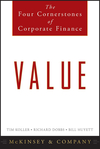Value
 Value: The Four Cornerstones of Corporate FinanceISBN: 978-0-470-42460-5
Hardcover
272 pages
November 2010
|
|||||||
Value
It’s surprising how often executives and boards make decisions that defy their own intuition about what creates lasting shareholder value. Market pressure, new financial engineering techniques, and misconceptions dressed as conventional wisdom all conspire against them. As all too recently witnessed, such misconceptions can damage companies and even the economies of entire countries.
A new book by McKinsey & Company, VALUE: The Four Cornerstones of Corporate Finance (Wiley; November 2010; $29.95; 978-047042460-5; Hardcover), provides a clean view into what drives corporate value creation—and what doesn’t—offering CEOs and other senior executives a stable basis for making sound, courageous, and sometimes unpopular strategic and financial decisions, even in the face of flawed thinking.
Understanding the four cornerstones explains why, for example:
- Growth isn’t always the key to value creation, despite the business world's obsession with it.
- Share repurchases, currently much in favor, rarely create value.
- Companies and investors should spend less time worrying about earnings guidance.
- The voices of a certain minority of investors should be heeded, and the rest should be ignored.
- Near-term changes in a company’s market valuation—often used to assess corporate performance and management compensation—are mostly due to factors beyond executives’ control.
- Earnings are inevitably variable, so trying to smooth them is a fool’s game.
- Divesting high-performing businesses can create more value than retaining them.
- Predicted EPS accretion or dilution is no indicator of an acquisition’s potential to create value.
The four cornerstones are built upon deep and broad McKinsey research and are illuminated with anecdotes, examples and company cases. The cornerstones are:
- The core of value: The combination of growth and return on capital, and resulting cash flow, drives value creation. This explains why some companies typically trade at high P/E multiples despite low growth. What’s important about this is that where a business stands in terms of growth and return on invested capital (ROIC) can drive significant changes in its strategy. For businesses with high returns on capital, improvements in growth create the most value; for businesses with low returns, improvements in ROIC provide the most value.
- The conservation of value: Value is created when companies generate higher cash flows, not by rearranging investors’ claims on those cash flows. When a company substitutes debt for equity or issues debt to repurchase shares, for instance, it changes the ownership of claims to its cash flows—but it typically doesn’t change the total available cash flows or add value, unless taxes change. Similarly, changing accounting techniques may create the illusion of higher performance without actually changing the cash flows, so it won’t change the value of a company.
- The expectations treadmill: A company’s performance in the stock market is driven by changes in the stock market’s expectations, not just the company’s actual performance (growth, ROIC and resulting cash flow). The higher the stock market’s expectations for a company’s share price become, the better a company has to perform just to keep up. Although certain companies can deliver unusually high total returns to shareholders for some period of time (usually no more than three years), they eventually hit a wall and disappoint.
- The best owner: There is no such number as an inherent value for a business; rather, a business’s value is relative to who owns it or might own it. Different owners will generate different cash flows for a business based on the strategies they pursue and their unique abilities to add value. Some, for instance, add value through unique links with other businesses in their portfolios, such as those with strong capabilities for accelerating the commercialization of products formally owned by upstart technology companies.
Value draws on research from the definitive reference on corporate finance and value creation, McKinsey’s Valuation: Measuring and Managing the Value of Companies. That book is now in its fifth edition, having sold more than 500,000 copies in 10 languages. But McKinsey came to see the need for a more accessible work to guide senior executives and board members through the quagmires of strategy formulation, business portfolio configuration and decisions about mergers and acquisitions.
“It’s one thing for a CFO to understand the mathematically based laws of valuation and apply them to the tools and processes that drive company performance. But it’s more powerful still when CEOs, board members and other non-financial executives understand the principles and practices of value,” says author Tim Koller. “Companies dedicated to value creation are more robust and build stronger economies, higher living standards, and more opportunities for individuals.”





